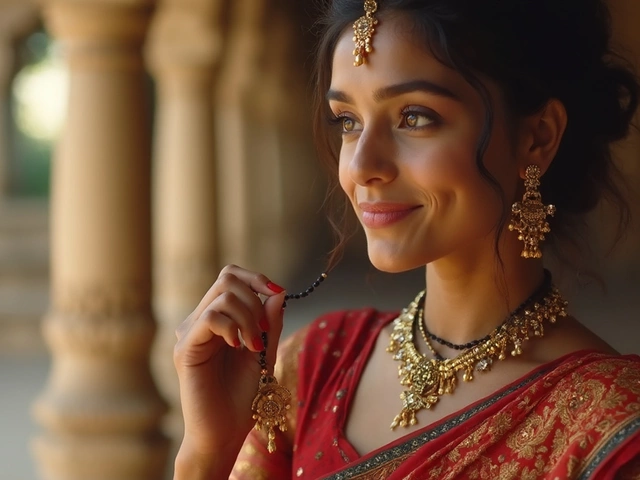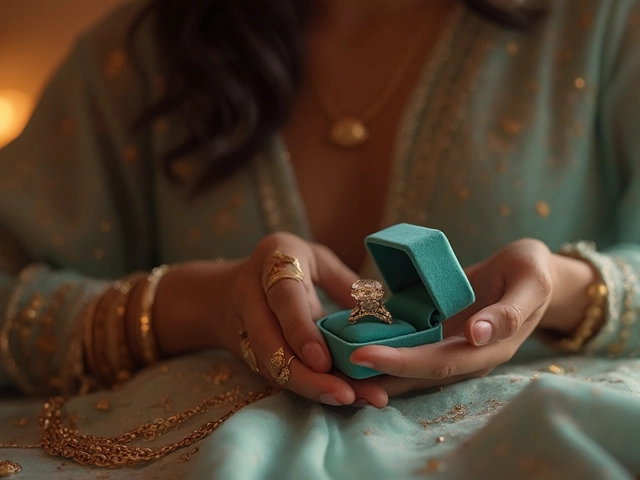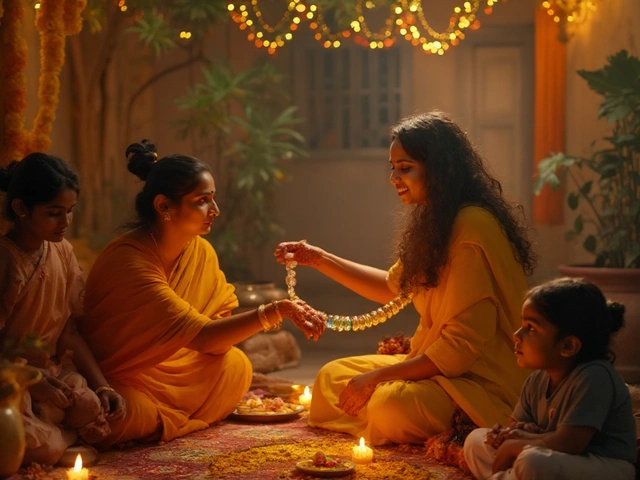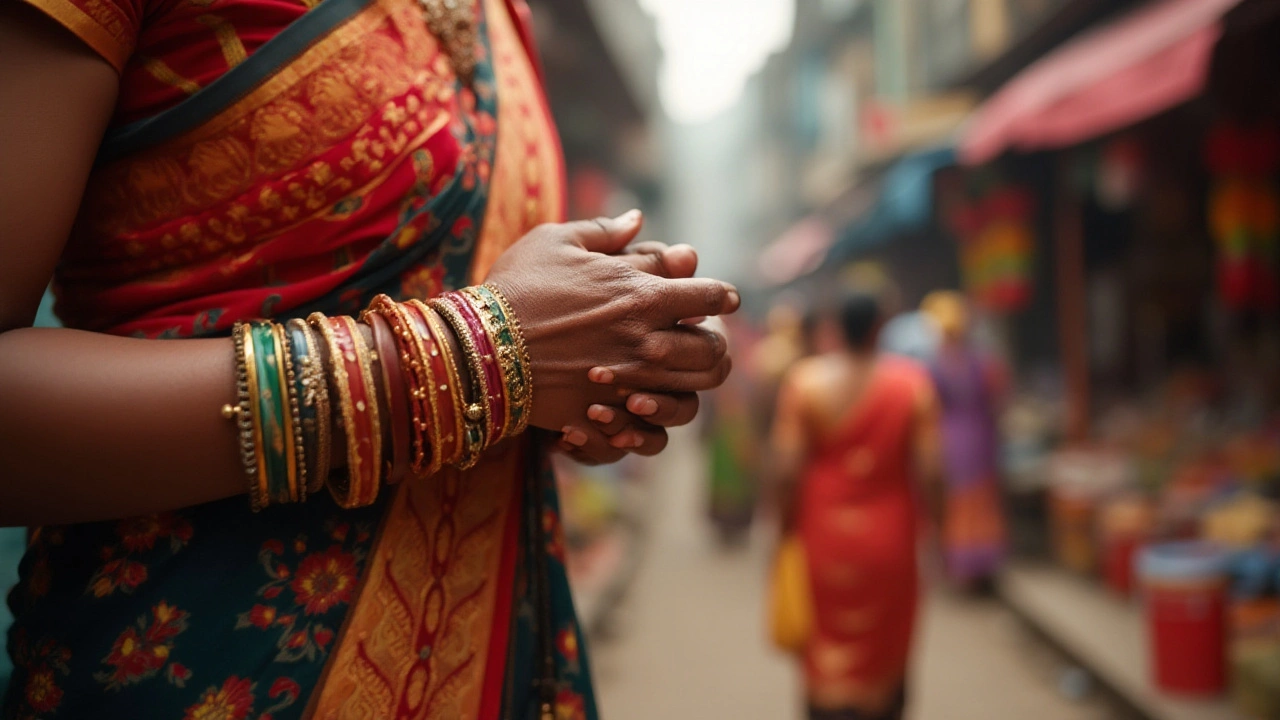
In the vibrant tapestry of Indian culture, bangles hold a special place. These colorful accessories are not just ornamental; they tell stories of tradition, reflect emotions, and echo cultural narratives. With myriad color options available, choosing the right set can be both exciting and meaningful.
Bangles have been a part of Indian heritage for centuries, with each color representing different facets of life—be it love, prosperity, or spirituality. Whether you're dressing for a wedding or looking for everyday elegance, knowing what colors to choose can enhance your outfit and the occasion.
Join us on a journey to discover which colors of bangles might suit your personal style and the significance they carry. From traditional reds and greens to modern hues, you'll find plenty of inspiration to brighten your jewelry collection.
- History of Indian Bangles
- Significance of Colors in Bangles
- Choosing Bangles for Various Occasions
- Cultural Trends in Bangle Colors
- Tips for Matching Bangles with Outfits
- Caring for Your Bangles
History of Indian Bangles
In the landscapes of ancient India, the bangles were not merely ornamental pieces of jewelry; they represented a confluence of art, emotion, and skill woven through generations. Steps back into archaeological realms reveal that bangles have adorned wrists since the dawn of civilization, with discoveries in the ruins of Mohenjo-Daro dating back to 2600 BCE. These early manifestations were crafted from a variety of raw materials like terracotta, stones, shells, and later, metals. The Indus Valley civilization holds testament to the craftsmanship of these artisans, who painstakingly created intricate patterns that mirrored the ethos of their age.
An intriguing aspect of traditional Indian bangles is their symbolic significance across varied cultural and regional contexts. In many parts of India, the colors and materials were representations of different life stages and events. For instance, glass bangles are synonymous with new beginnings and marital bliss for brides. In Maharashtra, a unique blend of green glass and delicate gold, known as 'Chooda,' holds spiritual and social importance. While these practices have evolved, they still retain a firm grounding in cultural traditions. Beyond symbolism, historical accounts like those from the Vedic texts and classical Indian literature highlight how bangles were intertwined with the very fabric of socio-cultural identity.
The evolution of bangles continued through the ages, reflecting the influences of various dynasties and empires that embraced the canvas of India. During the Mughal era, the sophistication in bangle design reached its pinnacle with the introduction of enamel work and embedded precious stones. Aesthetic complexity intertwined with stories of royal patronage illustrates why these pieces were cherished relics. As noted by author Alka Pande in her book on jewelry traditions, "Bangles are the poetic ornaments that celebrate femininity with strength, a symbol as diverse and resilient as the women who wear them." Their designs often mirrored the splendid opulence and intricate beauty of nature that was pivotal to the Mughal imagination.
In contemporary India, while the essence of traditional bangle significance remains, there is a delightful embrace of innovation that blends the old with the new. Modern artistry sees the integration of materials like plastic and silicon, coupling tradition with today’s aesthetic sensibilities. This dynamic balance keeps the essence of bangles alive yet ever-evolving, ensuring they remain a coveted accessory in the fashion world. As we reflect on this intriguing journey, it becomes clear that the history of traditional Indian bangles is much more than a history of adornment; it is a narrative of cultural resilience and timeless elegance.
Significance of Colors in Bangles
The colorful spectrum of traditional Indian bangles is much more than just a feast for the eyes. Each hue carries with it a tapestry of meanings, deeply rooted in cultural belief systems and customs. For instance, red is universally associated with love and passion in many parts of India. Brides often adorn crimson *bangles* as they're believed to bring prosperity and happiness to the marriage. Green, on the other hand, reflects fresh starts and fertility, making it a popular choice for new beginnings. Women wear these bangles during special ceremonies or festivals to symbolize growth and harmony in their lives. Historically, the color green has been worn by wives to indicate happiness and the renewal of family bonds.
Yellow, with its bright and cheery disposition, symbolizes happiness and optimism. It’s a color that often finds its place in bangle collections worn during auspicious occasions like childbirth or spring festivals like Vasant Panchami. Blue is another interesting choice, representing tranquility and peace. Though not traditionally as popular, its calming presence has found favor with the younger generations who incorporate it into their statement jewelry. White, traditionally associated with mourning, is less common in everyday life, but in many regions, it is gaining ground as a symbol of new beginnings and spirituality, aligning with more modern interpretations.
The traditional use of black bangles, believed to ward off evil and protect the wearer, is still in practice in many communities. Whether they're worn as a single bangle or interspersed with other colors, they serve both a cultural and protective purpose. India, known for such rich traditions, finds balance in diversifying its historical and modern sensibilities. As a quote from cultural historian Dr. Meena Pradhan suggests, "The color choice in traditional Indian jewelry is a dance between historical essence and personal expression," highlighting the evolving narrative of these timeless accessories.
Not just limited to traditional beliefs, modern interpretations of color bangles in India have seen a playful fusion, where women match bangles to their everyday attire. This not only showcases personal style but also embraces cultural heritage with a contemporary twist. Today, pastel colors like pinks and peaches have entered the scene, adding a versatile touch that allows for everyday wear across festivals, work, or casual outings. The bangle's color palette is ever-evolving, mirroring the dynamic blend of heritage and modern expressions prevalent in Indian fashion. Whether made of glass, metal, or lac, the vibrant hues continue to be an integral part of personal fashion, echoing cultural narratives throughout generations.
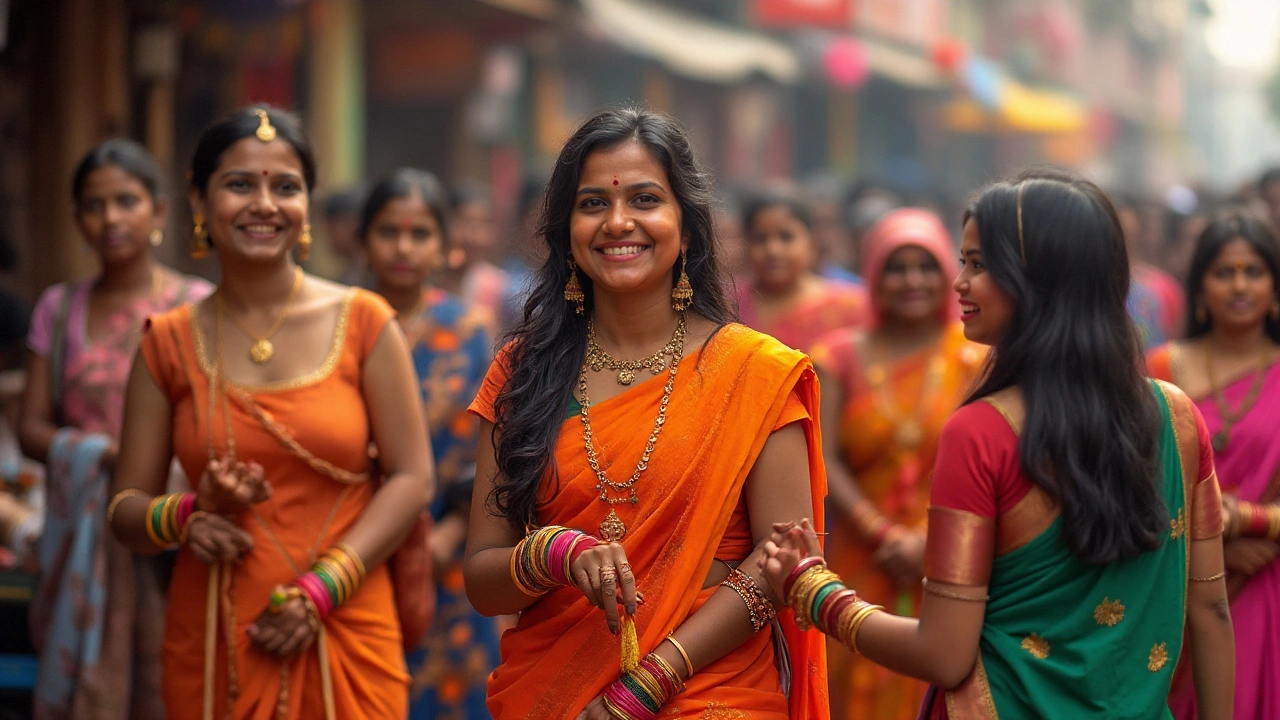
Choosing Bangles for Various Occasions
When it comes to selecting the right bangles for different occasions, the cultural and personal significance of colors plays a crucial role. In the world of traditional Indian jewelry, each color carries a unique meaning, making the choice of bangles a delightful mix of aesthetics and sentiment. For weddings, red is a popular choice, symbolizing love, prosperity, and fertility. It is not uncommon to see brides adorned with intricately designed red bangles that highlight their attire and add a touch of elegance. Gold and green are also favorites, often seen as symbols of wealth and fertility.
During festivals, vibrant colors like yellow and orange dominate the scene. These warm hues are associated with energy, positivity, and celebrations. They are perfect for festivities such as Diwali or Holi, when the spirit of joy is in the air. On religious occasions, wearing blue or white bangles might be ideal, as they represent spirituality and purity. An interesting detail many might not know is that different regions in India often have their unique interpretations and rituals involving bangles, which shows just how deep and varied this tradition is.
Unexpected events, such as work functions or casual gatherings, call for a more modern take. Here, you might opt for subtle shades like pastels or metallics. These choices blend traditional significance with a contemporary fashion sense. Metallics, especially silver and bronze, have recently gained popularity for their versatility and modern appeal. A well-known designer once stated, "The magic of bangles lies in their ability to adapt to time and occasion without losing their essence."
"The magic of bangles lies in their ability to adapt to time and occasion without losing their essence," said a well-known designer.
Everyday wear allows for flexibility and personal expression. Mixing bold colors like pinks with muted tones can create a quirky, stylish statement. For those keen on daily wear, bangles made from materials like glass, wood, or oxidized metals can be both practical and fashionable. This brings us to a bit of intriguing history: did you know that glass bangles are believed to possess protective qualities among several communities? These fascinating insights make the simple act of choosing bangles a meaningful journey of discovery and personal connection. So, next time you dress up, consider how the color of your bangles can powerfully communicate who you are and what the day means to you.
Cultural Trends in Bangle Colors
Throughout history, the color bangles have weaved themselves into the cultural fabric of India, echoing shifts in style, societal norms, and even technological advancements. The traditional colors like red and green have consistently held their ground, symbolizing marriage, fertility, and prosperity. Yet, in contemporary settings, these shades have been complemented by a kaleidoscope of hues, each representing the dynamic shifts in society. Modern iterations harness vibrant blues, purples, and even bold metallics, showcasing how the rich heritage adapts to the present-day vibrancy.
The significance of color transcends mere aesthetics; it embodies profound societal beliefs and aspirations. For instance, bridal bangles often feature deep reds, believed to bring good fortune, while yellow bangles might be worn during festive occasions to symbolize joy and happiness. In recent years, colors like turquoise and gold have surged in popularity during Diwali and other celebrations, not merely as a fashion statement but as an homage to the expansive cultural tapestry that these events denote.
Interestingly, the evolution of traditional Indian jewelry also coincides with global fashion trends, where fusion and minimalism have made their way into bangle designs. Designers now creatively blend Indian craftsmanship with international styles, resulting in pieces that appeal to a broad spectrum of audiences.
"Bangles are not just accessories; they are storytellers," says renowned designer Anita Dongre. "Their colors reflect the heartbeats of Indian culture, and each new trend unveils a new chapter."Such transformations reveal not just an accessorizing preference but also a deep-rooted connection to personal and collective identity in the ever-changing socio-cultural landscape.
A look at current data shows that demand for these innovative color schemes largely hinges on regional inclinations. As per a 2023 study on fashion trends within India, there is a significant interest in blending traditional patterns with modern silhouettes. The study indicated that urban populations exhibit a marked preference for metallic and pastel hues, while rural consumers remain enamored with vibrant primary colors, aligning with time-honored conventions. Here is an interesting table showcasing popular festival bangle colors based on regional preferences:
| Region | Popular Festival Colors |
|---|---|
| North India | Red, Green, Gold |
| South India | Yellow, Blue, Silver |
| East India | Black, White, Pink |
| West India | Orange, Turquoise, Bronze |
Such variations accentuate the rich diversity across the Indian subcontinent, making bangles an integral part of understanding and appreciating regional cultural flavors. Bearing this in mind, it becomes evident that as society evolves, so too do the colors of bangles, adapting and thriving alongside the people who cherish them. In today’s world, they act as vibrant threads woven through the vast tapestry that is Indian culture, symbolic of both unity and diversity.
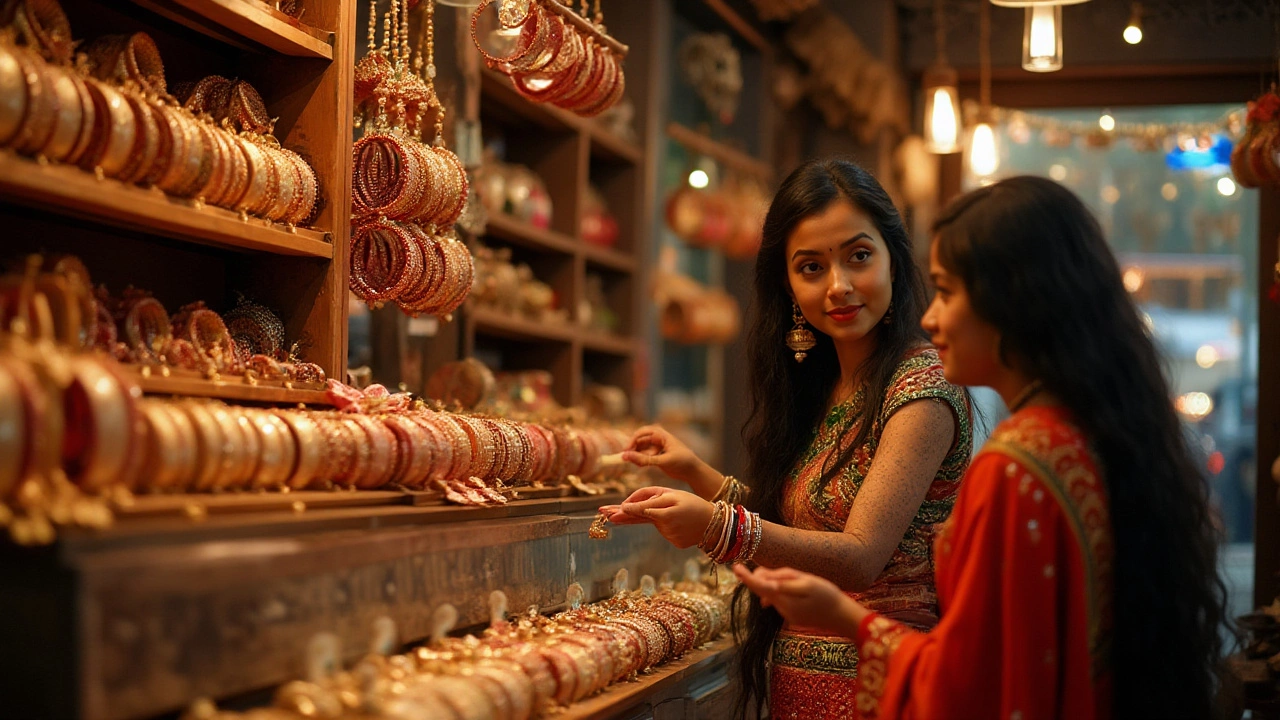
Tips for Matching Bangles with Outfits
When it comes to styling traditional Indian bangles with your outfits, you want to strike a harmonious balance between elegance and self-expression. Bangles, a staple in traditional Indian jewelry, offer a dazzling spectrum of colors and designs, each with its own allure and personality. Understanding the color dynamics and how they complement different attire is key to perfecting your look. Begin by considering the color palette of your outfit. Bright and vibrant bangles can add a splash of life to a muted ensemble, while delicate, pastel bangles provide a subtle charm to heavily embellished garments. The trick is to match the undertones: cool-toned outfits pair beautifully with blues, greens, and purples, whereas warm-toned dresses fit splendidly with reds, oranges, and gold.
Occasions matter too. For daytime events like a garden wedding or a casual brunch, choose lightweight and earthy colored bangles that reflect natural beauty. The delicate clinking sounds will surely charm through the softer hours of the day. On the other hand, pretty pastels or shimmery metallic bangles are great for evening gatherings where the setting sun can reflect off their shiny surfaces. If you’re attending a festive celebration, go bold with contrasting colors! Indian festivals celebrate color, and your bangles should too. A personal favorite of mine is pairing a rich, red silk saree with emerald green and gold bangles—it’s a classic combination full of vibrancy and tradition that always garners compliments.
Consider the personalities that you wish to project. When wearing bangles with western attire, you get to play with fusion fashion. Think bohemian outfits and layers—gracefully stack bangles of different textures and hues to create depth and character. Mixing metal with glass or wooden bangles can produce an eclectic and global style statement. For office settings, which require a more polished look, opt for slimmer, monochrome bangles in neutral colors that don’t jingle too obviously. This subtle accessory can be a delightful touch without breaking office decorum.
Quotes from designers often resonate with fashion enthusiasts. As famed fashion designer Coco Chanel once said, "Fashion is not something that exists in dresses only. Fashion is in the sky, in the street." Bangles, much in the same vein, can be the accessory that brings attention to an outfit and offers a peek into one's soul—the colors and combinations you choose tell your story. Lastly, give thought to the cultural symbolism behind certain colors. For example, red symbolizes prosperity in Hindu culture, and it is often used in bridal outfits, making it a significant color for wedding bangles. Similarly, green stands for fertility and happiness, a common choice during festivals and celebrations.
Caring for Your Bangles
When it comes to preserving the vibrant allure of your traditional Indian bangles, a little care goes a long way. These quintessential accessories are not just pieces of jewelry, but they are often loaded with memories and meaning. To keep them looking their best, start by cleaning them regularly. Use a soft, damp cloth to gently wipe away any dust or residues. For metallic and glass bangles, avoid using strong detergents as they can tarnish the sheen. Instead, opt for a mild soap mixed with water; this solution can be particularly effective in maintaining the shine without causing any harm to the surface.
Storing your bangles properly is equally crucial to prolong their life. Consider using a bangle box with individual compartments, which helps prevent the delicate designs from scratching against each other. If you have metal bangles, keeping them in a dry place is essential to avoid tarnishing and corrosion. Humidity can have a detrimental effect on the metal. To counter this, silica gel packets placed within your storage area can absorb excess moisture, keeping your treasures safe and sound. Investing in a soft pouch for each set is another simple yet efficient method; the fabric offers a layer of protection against abrasion.
Another tip is to be mindful during wear and tear. While traditional Indian bangles are crafted to withstand daily wear, being cautious about exposure to chemicals and perfumes can prevent potential discoloration or damage. Always put on your bangles after applying lotions or perfumes, ensuring they do not come into contact with these substances. An interesting practice shared by bangle aficionados is to rotate the bangles when slipping them off over the hands – this not only helps them glide smoothly but also minimizes stress on specific points, reducing the risk of breakage.
"The bangle is not just a circle of beauty; it's a circle of life, cradling tradition and style." – Anjali Surana, Jewelry Historian
Moreover, knowing when to take a break from wearing them can also play a role in maintaining their charm. While they make for a stunning display, giving your bangles a rest now and then prevents constant friction against rough surfaces, which can thin the bangles over time. Remember, prevention is better than cure. When traveling, consider dedicating a special container just for your bangles; keeping them cushioned and separate from other jewelry is key to avoiding unwanted knocks during transit.

